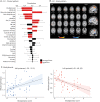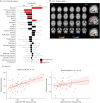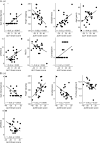99mTc-HMPAO SPECT Perfusion Signatures Associated With Clinical Progression in Patients With Isolated REM Sleep Behavior Disorder
- PMID: 38315966
- PMCID: PMC10890831
- DOI: 10.1212/WNL.0000000000208015
99mTc-HMPAO SPECT Perfusion Signatures Associated With Clinical Progression in Patients With Isolated REM Sleep Behavior Disorder
Abstract
Background and objectives: Idiopathic/isolated REM sleep behavior disorder (iRBD) is associated with dementia with Lewy bodies and Parkinson disease. Despite evidence of abnormal cerebral perfusion in iRBD, there is currently no pattern that can predict whether an individual will develop dementia with Lewy bodies or Parkinson disease. The objective was to identify a perfusion signature associated with conversion to dementia with Lewy bodies in iRBD.
Methods: Patients with iRBD underwent video-polysomnography, neurologic and neuropsychological assessments, and baseline 99mTc-HMPAO SPECT to assess relative cerebral blood flow. Partial least squares correlation was used to identify latent variables that maximized covariance between 27 clinical features and relative gray matter perfusion. Patient-specific scores on the latent variables were used to test the association with conversion to dementia with Lewy bodies compared with that with Parkinson disease. The signature's expression was also assessed in 24 patients with iRBD who underwent a second perfusion scan, 22 healthy controls, and 19 individuals with Parkinson disease.
Results: Of the 137 participants, 93 underwent SPECT processing, namely 52 patients with iRBD (67.9 years, 73% men), 19 patients with Parkinson disease (67.3 years, 37% men), and 22 controls (67.0 years, 73% men). Of the 47 patients with iRBD followed up longitudinally (4.5 years), 12 (26%) developed a manifest synucleinopathy (4 dementia with Lewy bodies and 8 Parkinson disease). Analysis revealed 2 latent variables between relative blood flow and clinical features: the first was associated with a broad set of features that included motor, cognitive, and perceptual variables, age, and sex; the second was mostly associated with cognitive features and RBD duration. When brought back into the patient's space, the expression of the first variable was associated with conversion to a manifest synucleinopathy, whereas the second was associated with conversion to dementia with Lewy bodies. The expression of the patterns changed over time and was associated with worse motor features.
Discussion: This study identified a brain perfusion signature associated with cognitive impairment in iRBD and transition to dementia with Lewy bodies. This signature, which can be derived from individual scans, has the potential to be developed into a biomarker that predicts dementia with Lewy bodies in at-risk individuals.
Conflict of interest statement
The authors report no relevant disclosures. Go to
Figures




References
MeSH terms
LinkOut - more resources
Full Text Sources
Medical
